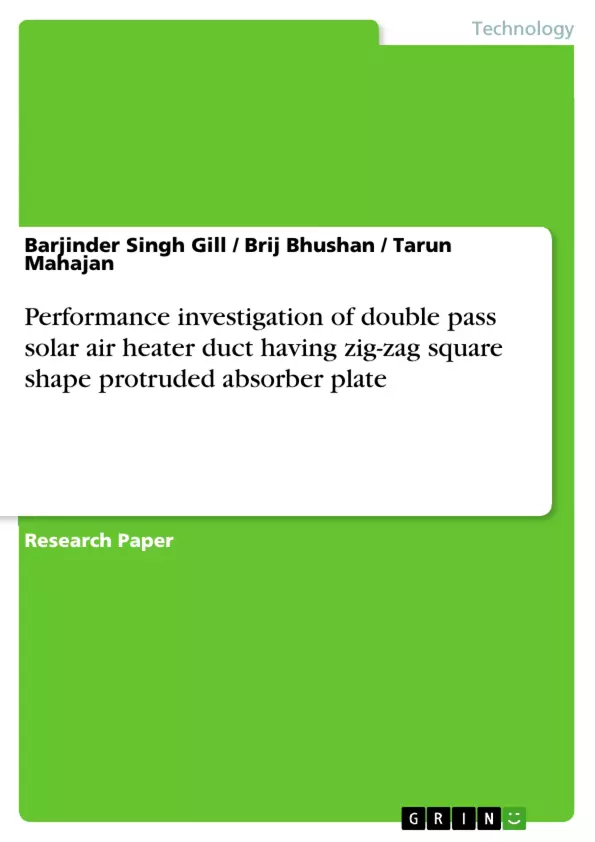This paper presents the effect of artificial roughness on the absorber plate for the double pass solar air heater duct. The roughness used on the absorber plate is of zig-zag square shape protrusions. It is observed that the protrusions on the one side of the absorber plate will form dimples on its other side. So there will be combined effect of protrusions and dimples on the heat transfer characteristics of the double pass solar heater.
Thermal and thermo hydraulic performance of the double pass solar air heater have been investigated for Reynolds number ranges of 6000-18000, for fixed values of relative longway length (L/e), relative shortway length (S/e), relative roughness height (e/) and aspect ratio of 25, 21.875, 0.03 and 10 respectively. Overall heat transfer coefficient of the system has also been evaluated and compared with the smooth duct.
Inhaltsverzeichnis (Table of Contents)
- Introduction
- Experimental Set-up
- Data Reduction
- Experimental Procedure
- Results & Discussions
- Variation of heat transfer coefficient with mass flow rate
- Variation of overall heat transfer coefficient with mass flow rate
- Variation of Thermal Efficiency with mass flow rate
- Variation of Thermohydraulic efficiency with mass flow rate
- Conclusion
- Acknowledgement
- References
Zielsetzung und Themenschwerpunkte (Objectives and Key Themes)
This paper investigates the impact of artificial roughness on the absorber plate of a double pass solar air heater (DPSAH) duct. The specific roughness employed is in the form of zig-zag square-shaped protrusions. The study aims to evaluate the thermal and thermo-hydraulic performance of the DPSAH with this modified absorber plate, comparing it to a smooth duct.
- Heat transfer characteristics of a double pass solar air heater duct with a roughened absorber plate
- Thermal efficiency of the DPSAH system
- Thermohydraulic efficiency of the DPSAH system
- Comparison of performance between the roughened DPSAH and a smooth duct
- Influence of artificial roughness on heat transfer and flow parameters
Zusammenfassung der Kapitel (Chapter Summaries)
The paper begins by introducing the concept of DPSAH and highlighting its advantages over single-pass systems. The experimental setup is then described, including details of the duct geometry, absorber plate, and instrumentation used for data collection. The paper then delves into the data reduction methods employed to calculate key performance parameters such as heat transfer coefficients, overall heat transfer coefficient, thermal efficiency, and thermohydraulic efficiency. Experimental procedures are outlined, emphasizing the importance of steady-state conditions and proper instrument calibration.
The results and discussions section presents a detailed analysis of the experimental findings. The paper explores the variation of heat transfer coefficient, overall heat transfer coefficient, thermal efficiency, and thermohydraulic efficiency with respect to mass flow rate. Comparisons between the roughened DPSAH and a smooth duct are highlighted, demonstrating the improvements in heat transfer and efficiency achieved through the use of artificial roughness.
Schlüsselwörter (Keywords)
The paper focuses on the design and performance of a double pass solar air heater with a roughened absorber plate. Key terms and concepts include: double pass solar air heater (DPSAH), artificial roughness, zig-zag square shape protrusions, overall heat transfer coefficient, thermal efficiency, thermohydraulic efficiency, mass flow rate, heat transfer coefficient, and experimental investigation.
- Quote paper
- Barjinder Singh Gill (Author), Brij Bhushan (Author), Tarun Mahajan (Author), 2016, Performance investigation of double pass solar air heater duct having zig-zag square shape protruded absorber plate, Munich, GRIN Verlag, https://www.grin.com/document/338381



